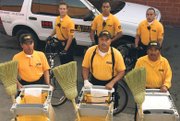L.A. Fashion District Scrubs Out Crime With 'Clean and Safe' Team
Los Angeles’ Fashion District borders some of the city’s meanest streets. But when Los Angeles Police Department officer Randall McCain discusses the district’s safety record, he might as well be talking about Beverly Hills.
“It’s like going to Rodeo Drive,” said McCain, the senior lead officer for the Fashion District and a 22-year veteran of the LAPD. “It’s a safe shopping area.”
McCain said the 90-square-block district, which is bordered by 7th Street to the north, the Santa Monica Freeway to the south, Spring and Main streets to the west and San Pedro Street to the east, has evolved from a crime-ridden eyesore to a safe haven today primarily due to the hard work of about 60 people.
In January 1996, the business improvement district’s group of 59 maintenance people and security guards—dubbed “the clean and safe team”—took responsibility for the round-the-clock safety of the Fashion District.
“They are the extra bodies we need,” McCain said.
While police department resources are stretched thin in the district—the lone police squad car deployed there often must respond to crimes in other areas—the business improvement district’s safe team of 24 security guards patrols the streets 24 hours a day.
Michael Gae, a longtime Fashion District worker, said the arrival of the yellow-shirted clean and safe team has improved the quality of life in the district.
“You were hesitant to park outside the building,” said Gae, who has co-owned the Rep Et Trois showroom in the district’s California Market Center since the mid-’80s. “You could be mugged. If women were unescorted, they were vulnerable. The area smelled and looked bad. It was pretty dreary.”
The turnaround started 10 years ago, when property owners in what is now called the Fashion District made a bold gambit to improve the area by forming the first business improvement district in Southern California. The 600 members of the district annually contribute a total of $3 million to fund the non-profit organization. The BID’s formula for urban renewal was later adopted in neighborhoods as diverse as Los Angeles’ Little Tokyo, Old Town Pasadena and downtown Long Beach.
Keeping it clean, safe
Every day, the 35 members of the clean and safe maintenance team paint over fresh graffiti and pick up seven tons of trash, said Kent Smith, the BID’s executive director.
The members of the safe team—all civilians, who earned security guard credentials filed with the state of California—are charged with dealing with homeless people who commit crimes. While they cannot arrest people who are drinking in public, they have been trained to tell law breakers that they are committing a crime, ask them to stop and call the police.
The team also tackles other nuisances such as aggressive panhandling, which is not a crime. In those instances, members of the safe team stand beside the panhandler and ask pedestrians whom the panhandlers approach not to donate spare change.
The safe team also accompanies Los Angeles city health inspectors on weekly sweeps against illegal food and CD vendors in the district. More than 20 vendors are given citations each week, McCain said.
Keeping crime low
The Fashion District’s safe team goes beyond acting as the eyes and ears of the police department when it is included as part of a law enforcement task force that fights non-violent crime. On May 24, the team took part in a sweep that seized $12 million worth of alleged counterfeit goods in Santee Alley. The task force picked up alleged counterfeit handbags, sunglasses, as well as alleged counterfeit garments that ripped off the styles of such brands as True Religion, 7 For All Mankind and Bebe. No arrests were made during the raid; McCain said 95 percent of the target area’s merchants ran away from their stands when they saw the task force.
Violent crime in the downtown Los Angeles area, which includes the Fashion District, has dropped 13 percent since Jan. 1, compared to the same time period last year, according to the LAPD. Smith could not confirm how far crime has declined in the Fashion District because police statisticians lump its crime statistics with adjacent, higher-crime areas. Yet, Smith contends that the Fashion District’s crime rates are similar to low-crime, upscale suburbs such as Brentwood in West Los Angeles.
Problem of perception
While sales of counterfeit items continue to be the district’s top crime and incidents of violent crime remain low, the district still grapples with a problem of perception. Many people just don’t think the area is safe after dark.
Stephanie Ghanem, a 20-year-old merchandising student from California State University, Northridge, said she leaves the Fashion District before the sun sets. “I love that it’s a busy area,” Ghanem said. “I’ve never been down there when I didn’t feel safe. But I try to avoid the area at night.”
Streets such as Main, Spring and Los Angeles are experiencing more residential development and could stimulate the emergence of additional businesses that would be open at night. Tiara Cafeacute; debuted on 9th Street, between Main and Los Angeles, in late May.
The restaurant’s general manager, Sharon McKenzie, said her business opened because there are more people living and working downtown. The restaurant only serves lunch, but McKenzie hopes evening activity in the district grows enough to warrant opening the restaurant for dinner.
Gae, meanwhile, said the district needs a beautification project or more greenery to break up the sea of concrete.
“I don’t feel like I’m in California when I’m in downtown L.A.,” Gae said. “It doesn’t feel alive as some place like Venice.”






















